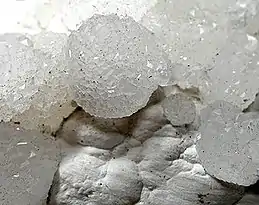Pinnoite
Pinnoite is a magnesium borate mineral with formula: MgB2O(OH)6[2][1] or MgB2O4·3(H2O).[3] It crystallizes in the tetragonal crystal system and occurs as colorless to yellow or light green radial fibrous clusters and rarely as short prismatic crystals.
| Pinnoite | |
|---|---|
 | |
| General | |
| Category | Borate mineral |
| Formula (repeating unit) | MgB2O(OH)6 |
| Strunz classification | 6.BB.05 |
| Crystal system | Tetragonal |
| Crystal class | Pyramidal (4) H-M symbol: (4) |
| Space group | P42 |
| Unit cell | a = 7.617 Å, c = 8.19 Å; Z = 4 |
| Identification | |
| Color | Colorless, light yellow, yellow green |
| Crystal habit | Short prismatic crystals uncommon; radial fibrous clusters |
| Fracture | Uneven |
| Mohs scale hardness | 3.5 |
| Luster | Vitreous |
| Diaphaneity | Translucent |
| Specific gravity | 2.27 |
| Optical properties | Uniaxial (+) |
| Refractive index | nω = 1.565 nε = 1.575 |
| Birefringence | δ = 0.010 |
| References | [1][2][3] |
Pinnoite was first described in 1884 for an occurrence in the Stassfurt potash deposit, Saxony-Anhalt, Germany and named for the mine counselor Oberbergrat Pinno of Halle, Germany.[2][1] It occurs in marine evaporite deposits and as efflorescence associated with mineral springs. It occurs with boracite and kaliborite.[2] It also occurs in the borax mines of Death Valley in California, the Da Quidam saline lake of the Qinghai-Xizang Plateau in Tibet and in Socacastro, Salta Province, Argentina.[2][1]